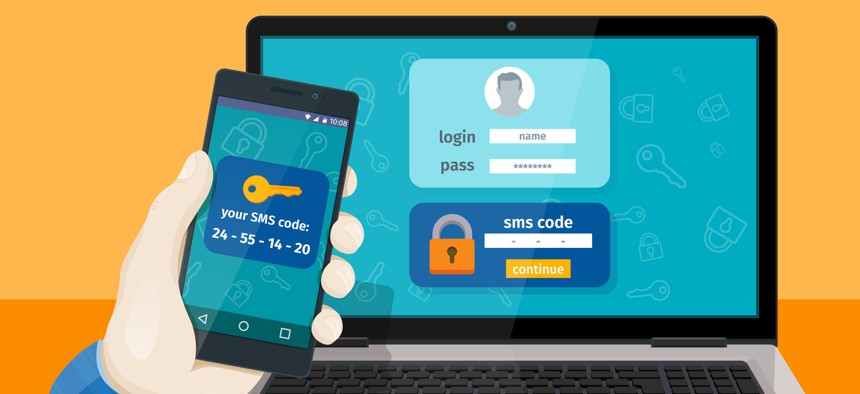FBI Cyber Crime Report Shows the Weakness of Password Protection

Stocker top/Shutterstock.com
It’s time we see passwords for the paper tigers that they are.
For my previous column, I demonstrated how quickly modern hacker tools could crack weak passwords, and why in some cases, the government probably shouldn’t rely on passwords at all. This week, there is even more evidence to support this claim as the FBI has released its latest report on internet crime.
The FBI’s 2019 Internet Crime Report covers all incidents of cyber crime reported to the bureau over the past year. And you might be surprised to learn that the most destructive cyber crime for 2019 in terms of money stolen isn’t something flashy like ransomware that is always making the news. It was business email compromise and email account compromise, which were grouped into one category. Basically, hackers take over an email account either by cracking the account password (the ease of which was demonstrated in my last column) or they use social engineering tactics to trick a user into giving them their password.
Once compromised, the email is used to initiate fake wire transfers from businesses or to steal bank information from private individuals. When a business suffers from this kind of crime, it’s called business email compromise. When a private person falls victim, the FBI calls it email account compromise. Both together resulted in almost $2 billion dollars in total losses in 2019. The total amount stolen, that was reported to the FBI, was $1,776,549,688. By comparison, ransomware losses amounted to a comparatively paltry $8,965,847.
Viruses and malware, which used to be the superstars of cyber crime, were close to the bottom of the list causing only $2,009,119 in damages last year. That’s still quite a lot, so you shouldn’t ditch your antivirus scanner anytime soon, but it’s clear that attackers have moved on to bigger and bolder techniques.
Same Motives, New Crimes
The FBI’s Internet Crime Complaint Center (IC3), which collects complaints about cyber crimes, saw a big uptick in new kinds of crime in 2019. One type that the report highlights in several places is SIM swapping. IC3 goes so far as to detail a specific case of SIM swapping in the San Francisco Bay area that resulted in the arrest of a small cartel of suspected scammers.
“San Francisco ultimately arrested three individuals in connection to these complaints, the most recent being the arrest of a SIM Swapping group leader which led to the seizures of over $18 million, five vehicles, a $900,000 home and hundreds of thousands of dollars in jewelry,” the report states. “The SIM Swapping scheme had targeted hundreds of victims, compromised hundreds of cryptocurrency accounts, and caused approximately $40 million in losses.”
In case you have not heard of SIM swapping before, you should consider yourself lucky. In a SIM swap scam, a criminal’s ultimate goal is to break the seemingly ironclad protection offered by two-factor or two-step verification found on high security, government and financial accounts. This is where the site sends a one-time, quickly expiring code to a user’s phone that must be typed exactly on a website in addition to a password for access.
Users generally get a text message with a number or alphanumeric sequence, and it must be entered within a few minutes or the password expires. In a SIM swap scam, hackers trick a carrier to switch a victim’s mobile number over to an account that the hackers own. This is easier than you might think. A phone is basically just a fancy computer supporting the subscriber identity module, or SIM, chip. And mobile carriers make it very easy to swap numbers these days.
But scammers need to do a little legwork first. They need to either collect personal information about a potential victim by buying it on the black market or use a phishing attack to try and mine the data directly. Once the scammers have enough information, they can convince their victim’s mobile carrier to swap the SIM. At that point, it’s just a matter of triggering the two-factor authentication process with the code going to the new phone that they control.
If that all seems like a lot of work, it is. But given the kind of accounts that two-factor authentication often protects, the payout is usually worth it for attackers.
Passwords Fail Again
Of course, with SIM swap attacks, a hacker also needs a site password to even initiate the sending of the second credential. But that does not seem to be a problem most of the time. It’s almost not a consideration for skilled attackers these days. So just in case this point hasn’t been pushed enough, here it is one more time: Passwords are increasingly worthless for protecting anything of value.
If you have two methods of protection guarding an account, and one of them is a password, then you functionally only have one protection scheme. Should a clever attacker find a way to compromise the second method, like what happens with a SIM swap attack, then you are going to get breached. Your password won’t be able to save you.
It’s time we see passwords for the paper tigers that they are, suitable only for low-level protection on something like a desktop computer in a home office. They are completely outclassed when trying to protect anything on a government network.
John Breeden II is an award-winning journalist and reviewer with over 20 years of experience covering technology. He is the CEO of the Tech Writers Bureau, a group that creates technological thought leadership content for organizations of all sizes. Twitter: @LabGuys



